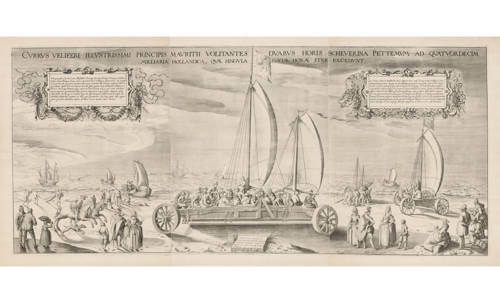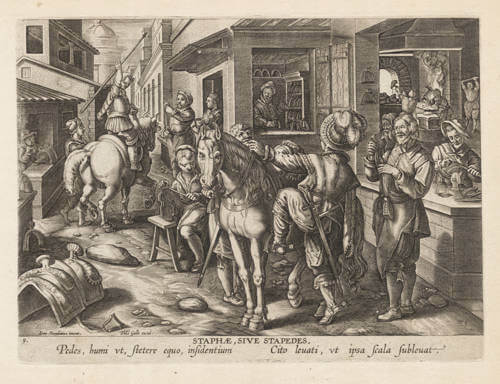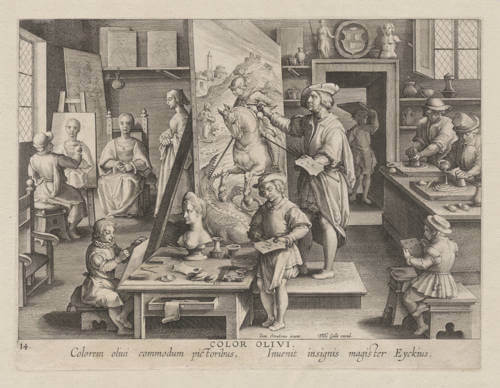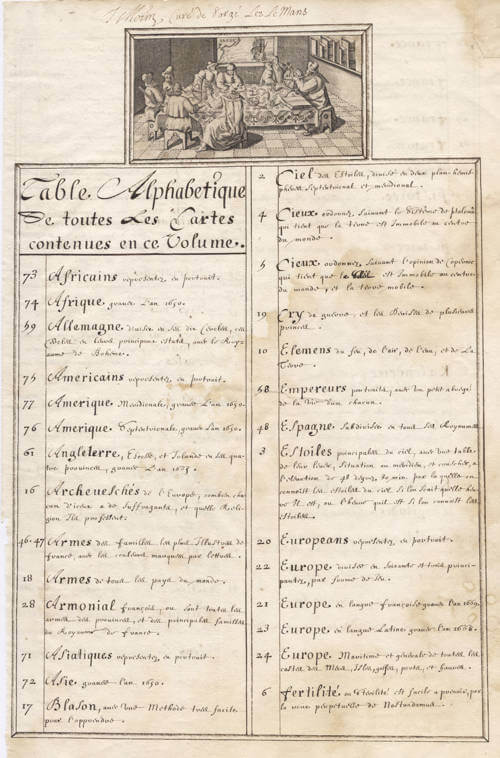Leen Helmink Antique Maps
Iconic print of Simon Stevin's Land Yacht
Stock number: 19435
Zoom ImageCartographer(s)
Jacques de Gheyn II (biography)
Title
Currus veliferi illustrissimi principis Mauritii volitantes duabus horis Scheverina Pettemum ad quatuordecim milliaria Hollandica, quae singula iustae horae iter excedunt
First Published
Amsterdam, 1603
This Edition
1652
Size
54 x 125.5 cms
Technique
Condition
mint
Price
$ 37,500.00
(Convert price to other currencies)
Description
THE LAND-YACHT OF 1603
A masterful huge illustration of a unique event in Dutch history
After Jacques de Gheyn II, engraved by Willem van Swanenburg
Copper engraving in 3 plates, each 54 x 42 cm, together 54 x 125.5 cm.
Along the top border of the print a two-line caption:
CVRRVS VELIFERI ILLVSTRISSIMI PRINCIPIS MAVRITII VOLITANTES DVABVS HORIS SCHEVERINA A PETTEMVM AD QVATVORDECIM MILLIARIA HOLLANDICA, QVAE SINGVLA IVSTAE HORAE EXCEDVNT
[The sailing cars of the most illustrious Prince Maurits, which in the space of two hours swept from Scheveningen to Petten, covering 14 Dutch miles, each of which requires a full hour of travel]
The print is signed at lower left of centre IDGheyn Inuentor and at lower right of centre CISwanenburch sculp. On stone at lower centre a dedication to Prince Maurits by Jacques de Gheyn.
Jacques de Gheyn’s large, three-plate engraving of the Sailing Car or Land Yacht tells its first expedition of Prince Maurits along the coast of Holland. The print is the only documentation that remains of the sailing car’s two-hour test ride, which took place in the spring of 1602 and ran along the beach for 14 Dutch miles. The car was invented as a curiosity, on Prince Maurits instigation, by Simon Stevin, mathematician and engineer to the prince. Like a sailboat with wheels, the car was intended to carry men across land in a vehicle powered by wind. With a favourable south-westerly wind that day, it apparently reached high speeds. As we see in Willem van Swanenburgh’s engraving, two sailing cars were actually built, the large one which made its test run on this occasion and a smaller prototype that had apparently been tested before.
According to the text, 27 participants accompanied the Prince Maurits that day, including Ulrich of Holstein, brother of Christian IV of Denmark, Prince Frederik Hendrik, Paul Choart de Buzanval, the French ambassador in The Hague, Hugo Grotius, and it is assumed , Jacques de Gheyn, who possibly sketched some figures on the print from life.
The print appeared for the first time in 1603 and was published jointly by Hendrick Hastens and Christoffel van Sichem. Jacques de Gheyn was paid 70 guilders in 1603 for coloured impressions of the prints by the States General, but he was not in charge of the distribution of the print. The popular engraving had a long history of reprinting and copying through the first half of the 17th century. The plates were reissued in 1612 by Van Sichem and Dirck Pietersz. Voskuyl, with the addition of the large blank cartouches on either side of the sailing car filled with letterpress text. Some time later, Hendrick Hondius, print publisher in The Hague, obtained the plates and filled the cartouches with engraved text in Latin and French. Claes Jansz. Visscher finally reprinted the plates in 1652, following Hondius’s death in 1650.
Condition
Dark and even imprint of the copperplates. Wide margins. Here in the 1652 re-issue by Claes Janszoon Visscher. Pristine condition.
Literature
Frederick Muller, Hist. Platen 1157 a-d
Atlas Van Stolk 1106
A. Eijffinger, ‘Zin en Beeld’. Enige kanttekeningen bij twee historieprenten’. In: Oud Holland 93 (1979) 251-269
Dawn of Golden Age. Northern Netherlandish Art 1580-1620. (Ger Luijten e.a. eds.). Amsterdam Rijksmuseum / Zwolle Waanders Uitgevers, 1993, nr. 209.
Hollstein, Vol. XXIX, nr. 27.
The New Hollstein. The De Gheyn Family. Rotterdam 2000, Part II, nr. 172.
Jacques de Gheyn II (c. 1565–1629)
Jacques de Gheyn II (c. 1565–1629) was a pivotal figure in the Dutch Golden Age, celebrated as a painter, engraver, and draftsman whose work bridged the ornate Northern Mannerism of the late 16th century with the emerging realism of Dutch art. Born in Antwerp to a glass painter and engraver, Jacques de Gheyn I, he developed an early aptitude for art, later honing his skills under the tutelage of Hendrick Goltzius in Haarlem from 1585 to 1590. De Gheyn’s career, spanning Antwerp, Haarlem, Leiden, and The Hague, was marked by versatility, innovation, and close ties to the House of Orange, particularly Prince Maurits. His oeuvre includes some of the earliest vanitas still lifes, floral studies, and female nudes in Dutch art, alongside over 1,500 drawings and numerous engravings. Among his most notable works is the monumental three-sheet engraving of Prins Maurits’ Land Yaght, a testament to his skill and his role in documenting Dutch ingenuity and princely ambition.
De Gheyn’s early training under his father and Goltzius instilled a meticulous approach to engraving, evident in his first major commission in 1593: an engraving of the Siege of Geertruidenberg for Prince Maurits, which served as propaganda to bolster the prince’s reputation as a military leader. By the mid-1590s, De Gheyn settled in Leiden, where he collaborated with the scholar Hugo Grotius, producing engravings for Grotius’ Syntagma Arateorum (1600), which illustrated constellations with precision. His marriage to Eva Stalpaert van der Wiele in 1595, a wealthy woman from Mechelen, provided financial stability, enabling him to pursue ambitious projects. Around 1600, De Gheyn shifted focus from engraving to painting and etching, creating works like the Vanitas Still Life (1603, Metropolitan Museum of Art), considered the earliest of its kind in the Netherlands. In 1605, he moved to The Hague, where he became a favored artist of the Dutch court, joining the Guild of St. Luke and designing innovative gardens for Prince Maurits, including the Buitenhof garden with the Netherlands’ first grottoes.
De Gheyn’s monumental three-sheet engraving, Prins Maurits’ Land Yaght (c. 1602–1603, Rijksmuseum), is a highlight of his career, though its attribution remains debated. This expansive print, measuring approximately 45 inches across, depicts a historic event: Prince Maurits and 27 guests sailing in two land yachts, or “sand chariots,” designed by Simon Stevin, from Scheveningen to Petten in 1602. The land yacht, a wind-powered vehicle, symbolized Dutch technological prowess during the war of independence against Spain. The engraving captures the yacht in motion, with billowing sails, detailed rigging, and a retinue of figures, set against a coastal landscape. Its scale and complexity reflect De Gheyn’s technical virtuosity, likely executed in collaboration with Willem Isaacszoon van Swanenburg, to whom the Rijksmuseum attributes the work, though some sources suggest De Gheyn’s design was central. The print served as both a scientific record and a celebration of Maurits’ patronage, aligning with De Gheyn’s role in promoting the prince’s image, as seen in earlier works like the Exercise of Armes (1607), a military manual with 117 engravings commissioned by Maurits.
De Gheyn’s broader contributions to Dutch art were profound. His drawings, ranging from natural history studies to landscapes, showcase his curiosity and versatility, with over 1,500 attributed to him. His engravings, such as the portrait of Tycho Brahe for Astronomiae instauratae mechanica (1602) and Carolus Clusius for Rariorum plantarum historia (1601), demonstrate his skill in scientific illustration. Paintings like the Spanish Warhorse (1603, Rijksmuseum), depicting a horse captured during the Battle of Nieuwpoort and presented to Maurits, highlight his ability to imbue historical subjects with grandeur. Unlike many contemporaries, De Gheyn never traveled to Italy, and his work shows minimal influence from classical antiquity, except in his garden designs. His shift toward Calvinism, despite a Catholic upbringing, and his engagement with Leiden’s intellectual circles further shaped his subject matter, which often blended reality and imagination, as noted by Karel van Mander.
On a personal level, De Gheyn was a respected figure in The Hague, where he died on March 29, 1629. His son, Jacob de Gheyn III, born in 1596, followed in his footsteps as an engraver and was famously portrayed by Rembrandt in 1632 alongside Maurits Huygens, reflecting the family’s cultural prominence. De Gheyn’s connections with the Huygens family and Prince Frederick Henry, Maurits’ successor, underscore his integration into elite Dutch society. His work for the House of Orange, from garden designs to engravings, cemented his legacy as an artist who not only documented but also shaped the visual culture of the Dutch Republic.
The Prins Maurits’ Land Yaght engraving encapsulates De Gheyn’s ability to merge art, science, and politics. Its monumental scale and detailed execution made it a celebrated image of Dutch innovation, while its debated attribution highlights the collaborative nature of printmaking in the period. De Gheyn’s broader oeuvre, from vanitas still lifes to military manuals, reflects the dynamic cultural and intellectual currents of the Dutch Golden Age. His legacy endures in collections like the Rijksmuseum, the Metropolitan Museum of Art, and the Getty, where his works continue to illuminate the transition from Mannerism to realism and the vibrancy of 17th-century Dutch art.
Sources
Rijksmuseum: Jacques de Gheyn II, Spanish Warhorse and Land Yaght
The Metropolitan Museum of Art: Jacques de Gheyn II, Vanitas Still Life
Linda Hall Library: Jacques de Gheyn II, Scientific Engravings
Wikipedia: Jacques de Gheyn II
Dayton Art Institute: Jacques de Gheyn II Biography






